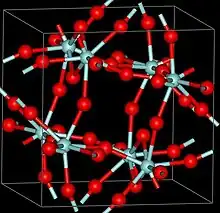Zirconium tetrafluoride
Zirconium(IV) fluoride describes members of a family inorganic compounds with the formula (ZrF4(H2O)x. All are colorless, diamagnetic solids. Anhydrous Zirconium(IV) fluoride' is a component of ZBLAN fluoride glass.[2]
-fluorid.png.webp) | |
| Names | |
|---|---|
| IUPAC names
Zirconium(IV) fluoride Zirconium tetrafluoride | |
| Identifiers | |
| |
3D model (JSmol) |
|
| ChemSpider | |
| ECHA InfoCard | 100.029.107 |
| EC Number |
|
PubChem CID |
|
| UNII | |
CompTox Dashboard (EPA) |
|
| |
| |
| Properties | |
| ZrF4 | |
| Molar mass | 167.21 g/mol |
| Appearance | white crystalline powder |
| Density | 4.43 g/cm3 (20 °C) |
| Melting point | 910 °C (1,670 °F; 1,180 K) |
| 1.32 g/100mL (20 °C) 1.388 g/100mL (25 °C) | |
| Structure | |
| Monoclinic, mS60 | |
| C12/c1, No. 15 | |
| Hazards | |
| Flash point | Non-flammable |
| Lethal dose or concentration (LD, LC): | |
LD50 (median dose) |
98 mg/kg (oral, mouse) 98 mg/kg (oral, rat)[1] |
| Related compounds | |
Other anions |
Zirconium(IV) chloride Zirconium(IV) bromide Zirconium(IV) iodide |
Other cations |
Titanium(IV) fluoride Hafnium(IV) fluoride |
Except where otherwise noted, data are given for materials in their standard state (at 25 °C [77 °F], 100 kPa).
Infobox references | |
Structure

Three crystalline phases of ZrF4 have been reported, α (monoclinic), β (tetragonal, Pearson symbol tP40, space group P42/m, No 84) and γ (unknown structure). β and γ phases are unstable and irreversibly transform into the α phase at 400 °C.[3]
Zirconium(IV) fluoride forms several hydrates. The trihydrate has the structure (μ−F)2[ZrF3(H20)3]2.[4]
Preparation and reactions
Zirconium fluoride can be produced by several methods. Zirconium dioxide reacts with hydrogen fluoride and hydrofluoric acid to afford the anhydrous and monohydrates:
- ZrO2 + 4 HF → ZrF4 + 2 H2O
The reaction of Zr metal reacts at high temperatures with HF as well:
- Zr + 4 HF → ZrF4 + 2 H2
Zirconium dioxide reacts at 200 °C with solid ammonium bifluoride to give the heptafluorozirconate salt, which can be converted to the tetrafluoride at 500 °C:
- 2ZrO2 + 7 (NH4)HF2 → 2 (NH4)3ZrF7 + 4 H2O + NH3
- (NH4)3ZrF7 → ZrF4 + 3 HF + 3 NH3
Addition of hydrofluoric acid to solutions of zirconium nitrate precipitates solid monohydrate. Hydrates of zirconium tetrafluoride can be dehydrated by heating under a stream of hydrogen fluoride.
Zirconium fluoride can be purified by distillation or sublimation.[2]
Zirconium fluoride forms double salts with other fluorides. The most prominent is potassium hexafluorozironate, formed by fusion of potassium fluoride and zirconium tetrafluoride:
- ZrF4 + 2 KF → K2ZrF6
Applications
The major and perhaps only commercial application of zirconium fluoride is as a precursor to ZBLAN glasses.[2]
Mixture of sodium fluoride, zirconium fluoride, and uranium tetrafluoride (53-41-6 mol.%) was used as a coolant in the Aircraft Reactor Experiment. A mixture of lithium fluoride, beryllium fluoride, zirconium fluoride, and uranium-233 tetrafluoride was used in the Molten-Salt Reactor Experiment. (Uranium-233 is used in the thorium fuel cycle reactors.)
References
- "Zirconium compounds (as Zr)". Immediately Dangerous to Life or Health Concentrations (IDLH). National Institute for Occupational Safety and Health (NIOSH).
- Nielsen, Ralph (2000). "Zirconium and Zirconium Compounds". Ullmann's Encyclopedia of Industrial Chemistry. doi:10.1002/14356007.a28_543. ISBN 3527306730.
- Paul L. Brown; Federico J. Mompean; Jane Perrone; Myriam Illemassène (2005). Chemical thermodynamics of zirconium. Gulf Professional Publishing. p. 144. ISBN 0-444-51803-7.
- Greenwood, Norman N.; Earnshaw, Alan (1997). Chemistry of the Elements (2nd ed.). Butterworth-Heinemann. p. 965. ISBN 978-0-08-037941-8.
- ORNL/TM-2006/12 Assessment of Candidate Molten Salt Coolants for the Advanced High-Temperature Reactor (AHTR), March 2006 (Accessed 2008/9/18)